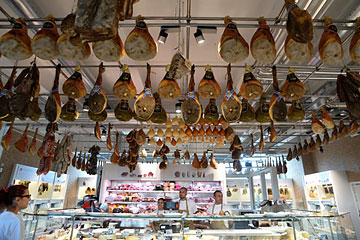
Small-batch specialty hams are among the 3,000 products on the shelves at Eataly
(2 of 2)
The chain works closely with those suppliers, handling the paperwork and shipping logistics for some 700 Italian producers. Presidio del Macagn, a cheese-maker in the Piedmontese Alps, began selling its products in Eataly's Torino location in 2007. Manuela Ceruti, 38, and her husband produce about 5,000 kg of cheese a year. Since the Cerutis began selling to Eataly, they've seen a jump of about 60% in revenue, mostly due to an ability to command a higher price. "Slow food says, 'This is good. This is traditional,'" says Ceruti. "But as long as you can't sell it, those are only words." If not for Eataly, she adds, she would probably have had to close up shop like many of her neighbors. Instead, she shipped her first batch of cheese to Rome in September.
The formula is fueling Eataly's global growth. The company has nine locations in Italy, 11 Eataly minimarts in Tokyo and one U.S. flagship market-restaurant-bar in New York, employing some 2,500 people altogether. In 2013 it plans to open four new stores in Italy as well as ones in Istanbul, Dubai and Chicago. While Eataly may have its roots in the Italian countryside, its future in the U.S. depends on well-to-do urbanites who are willing to pay premium prices, says Harry Balzer, vice president of the research firm NPD Group. "Is there a market for what they're doing? Absolutely," Balzer says. "But it's going to have everything to do with location. They're going to have to be in places where there's affluence."
At a time when consumers are tightening their belts, revenue at Eataly has been growing at 25% to 30% a year, according to Oscar Farinetti, and the privately held company expects sales of roughly $400 million this year. Unlike in the U.S., where Eataly pulls in most of its revenue from its restaurants — the New York Eataly alone accounts for about $70 million in sales — in Italy, the retail arm dominates. On a Monday, roughly 10,000 shoppers enter the Rome store. On weekends, the number of visitors can reach 25,000. "We feed between 5,000 and 8,000 people a day, people who sit and eat," Nicola Farinetti says.
Slow-food advocates point out that Eataly isn't perfect. It's far too reliant on producers near its home base in Torino, for instance. But it is a step in the right direction, says Roberto Burdese, head of Slow Food Italy. "If all the big supermarkets worked like Eataly, we'd have resolved many problems."
To be sure, being sold in Eataly hasn't solved all Il Conciato's problems. Vadalà and his business partner, Vincenzo Mancino, worry about sacrificing quality by ramping up too quickly. Their cheese's distinctive flavor comes from a carefully blended mix of thyme, oregano, fennel, bay leaves and garlic — a process that does not easily scale up. And while Mancino handles the marketing, Vadalà has yet to find someone to help in his workshop. For the moment, they're taking it, well, slow. "If and when they start asking for our cheese in Torino, in Milan, in New York, then we'll have to make some decisions," says Mancino. "For the moment, our main objective is to keep it alive."
